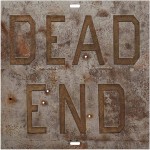While we pursue more information than we did in the past, we have become less apt to retain most of which we learn because of our ever-present access to the Internet.
This is because most every word and image has been documented digitally and can be found online in what is now the world’s largest archive.
Theories on Forgetting prompts viewers to grapple with this reality and to reflect upon the various ways that information has been archived over the centuries by questioning the origination, recognition, obsolescence, and renewal of popular imagery.
Aggregating works by eighteen artists, the exhibition is divided between Gagosian’s two lower galleries. Works by Sterling Ruby, Mungo Thompson, Douglas Gordon, Mark Flood, Thomas Ruff, and Cady Noland occupy the North Gallery while the south gallery arrays pieces by Analia Saban, Piero Golia, Oliver Laric, Richard Philips, Taryn Simon, Jonas Wood, Ed Ruscha, Max Hooper Schneider, Christian Jankowski, Mark Hagen, John Houck, and Ana Mendieta.
Sterling Ruby ’s bronze sculpture “Trough” (2014) is the subtly apt centerpiece for the North Gallery. Cast from a makeshift container that the artist used to catch the run-off while pouring urethane sculptures, the piece evokes a twin-sized bed where lost memories can be reconnected through the subconscious.
Surrounding Ruby’s work hang Mungo Thompson’s “April 22, 2013” (2014) and Douglas Gordon’s “Self Portrait of You + Me (Jackie smiling II)” (2008). Both of these pieces are mirrored and feature iconic imagery that functions as definitive placeholders reflective of the past that continue to impart influence upon an ever-changing society.
Also in the North Gallery, two of Mark Flood’s large-scale paintings expand the notion of elapsing time. “CNN Bloodmist” (2014) and “Fox News HURT LOCKER” (2014) both invoke bit-rot, the degradation of digital data. According to Melissa Smith for Capital, Floods’ “portrayal of [CNN and Fox News’] logos as fractured digital images provides an ironic sense of time – everything that is new is then old.”
Two installations that anchor the South Gallery include Analia Saban’s “Claim (from Chair)” (2013) and Piero Golia’s “On Record (Three days conversation on general matters)” (2014). Each include a sitting area that together conjure the feel of a library, whose inventory, like sleep, also has the capacity to activate the subconscious.
Interestingly, Saban’s piece includes a chair that she inherited from one of her teachers, and studio’s former owner, John Baldessari. The chair doesn’t only act as a cultural artifact but again signals us to consider the significance that our predecessors continue to exert upon us.
Golia’s installation also calls attention to how the past remains formative to new understanding. At the center of his piece is a stenographic transcript that provides the detail from a 16 hour conversation that took place over a three day period at the 2014 Los Angeles Art Book Fair. A rare professional, versed in the almost extinct art of analog record keeping, was hired to read from the transcript during the exhibition’s opening and is scheduled for a second reading on August 21 between 12 noon and 6 pm.
Other works in the South Gallery include “Mars” (2015) by Oliver Laric and Richard Philips’ “Records” (2014) and “Cooking” (2014). While Laric uses 3D technology to analyze the evolution of age-old artifacts to cheap reproductions, Philips relies upon the graphics and typography of decades old textbooks as a means to comment upon the evolving tradition of popular image preservation.
Also of note are Taryn Simon’s contributions to Theories on Forgetting. Both “Folder: Abandoned Buildings & Towns” (2012) and “Folder: Mirrors” (2012) revisit life before the explosion of the Internet. Like Pinterest boards, categorized by subject, these two works comprise photographs of related images that Simon handpicked from various categories that complete New York Public Library’s famous Picture Collection. Despite this archive’s paltry scope when compared to our current one-click catalog, Simon’s work doesn’t only acknowledge our inherent fascination with printed imagery, but she references the exhaustive collection as a precursor to the Internet.
Like Simon, Jonas Wood also appropriates imagery from the past. Sourced from the Metropolitan Museum of Art, his untitled charcoal renderings of ancient urns reflect his obvious intrigue with Greek pottery.
And then there are a handful of works that play with the idea of signage and the historical context with which such is linked. Ed Ruscha’s “Rusty Signs – Dead End 1” (2014) and “Rusty Signs – Cash for Tools 2” (2014) are in fact new works on paper, each of which have been manipulated to assume the look of corroded metal. And Max Hooper Schneider’s piece, “The Extinction of Neon” (2015), is an acrylic terrarium, complete with plastic flora and insect matter that surround discarded neon words, obfuscated by what we can only assume to be the world’s perseverant determination to move forward.
- DOUGLAS GORDON, Self Portrait of You + Me (Jackie smiling II), 2008 , Burned print, smoke and mirror , 45 3/8 x 36 13/16 inches , 115.2 x 93.5 cm. ©Studio lost but found / VG Bild-Kunst, Bonn 2015. Courtesy of Gagosian Gallery.
- ED RUSCHA, Rusty Signs – Dead End 1, 2014, Mixografía® print on handmade paper, 24 x 24 inches , 61 x 61 cm., Edition of 50. ©Ed Ruscha. Courtesy of the artist and Gagosian Gallery.
- MARK FLOOD . Fox News HURT LOCKER, 2014 , Archival ink on canvas 72 x 107 inches, 182.9 x 271.8 cm. ©Mark Flood. Courtesy of Peres Projects, Berlin, and Gagosian Gallery. Photo by Hans-Georg Gaul.
Rounding out the exhibition is Christian Jankowski’s film installation “Casting Jesus” (2011), a split screen piece in which the Vatican plays host to a casting session in search of the perfect face to star as the almighty Christ. On one screen, contestants read for the role of Jesus while on the other a panel of experts in divinity scrutinize each actor.
As a society preoccupied with progress, we are more inclined to focus on the future than to look to the past. Rarely do we stop to acknowledge the efforts of our predecessors because we hold the assumption that our access to technology has made us smarter if not superior.
Theories on Forgetting presents an insightful discourse on the cyclical rise and fall of cultural symbolism. Yet more importantly it asks us to question the consequences that have come with “forgetting” and to instead recognize history as a vehicle through which we can access enlightened awareness.
Theories on Forgetting runs through August 21 at Gagosian Gallery, located at 456 North Camden Drive in Beverly Hills.
–Anise Stevens






